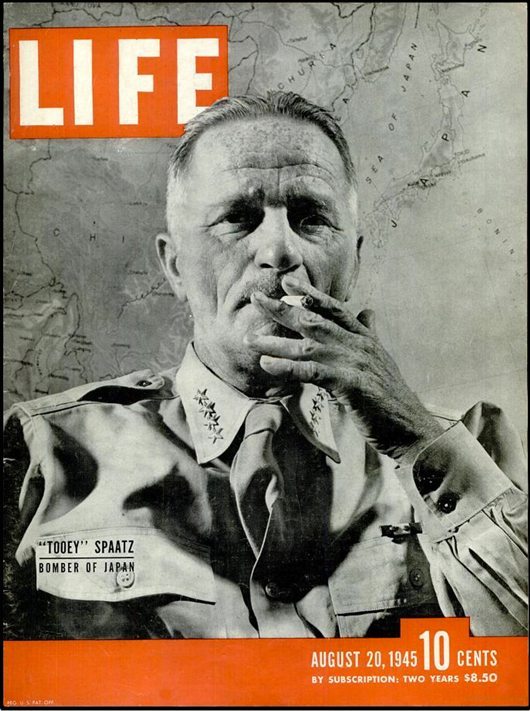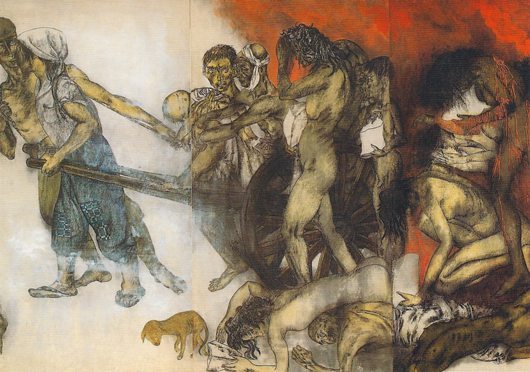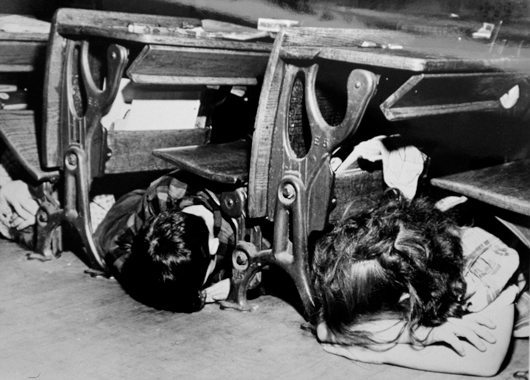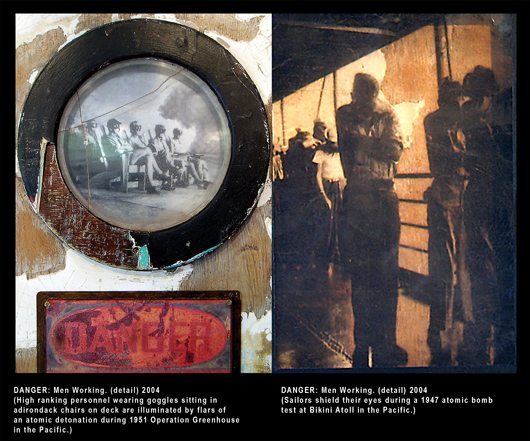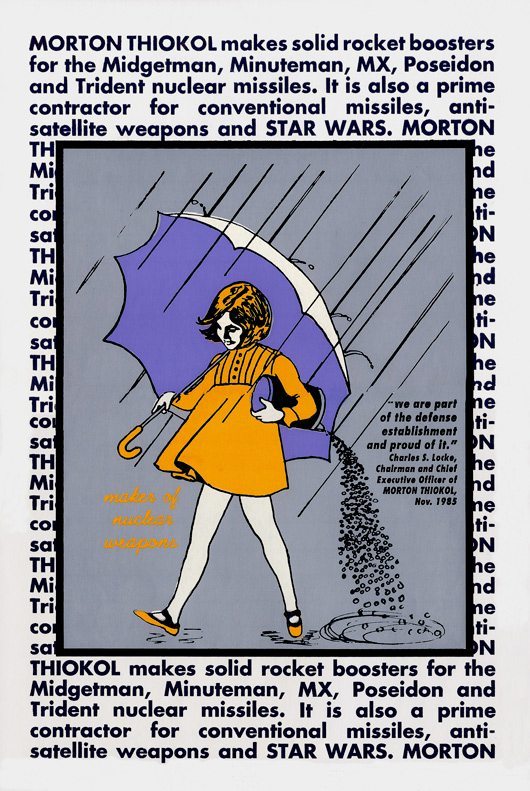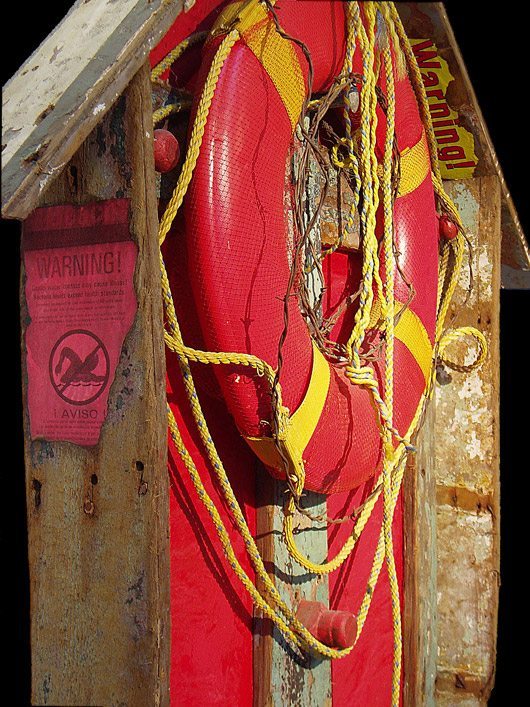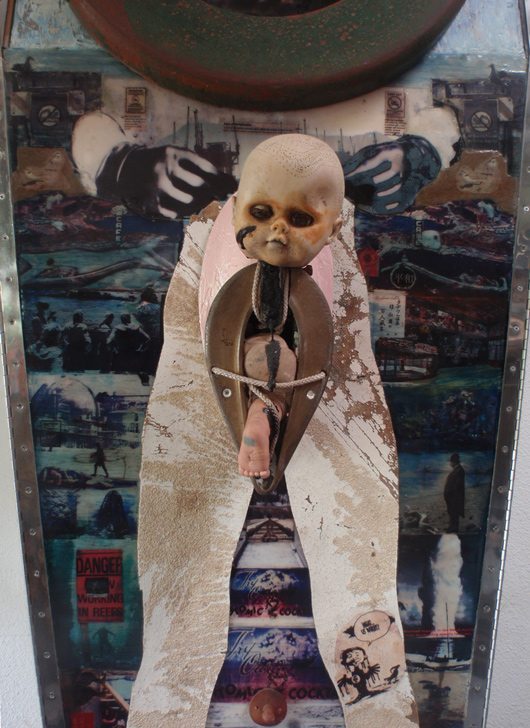Location: California
Dedicated to my brother, Joseph Jeremiah Lynch, March 26, 1952 – July 25, 2005.
INTRODUCTION
IN CONTEMPLATING SEVEN DECADES OF the detrimental effects nuclear technology has had on our global landscape and the enormous consequences it may have on our very existence, I’ve tried to sort out the ways in which the reality of life growing up in the nuclear age has affected my own consciousness.
It is clear to me first and foremost that I’ve written this article with the full knowledge that I am a downwinder, second to the youngest of seven brothers and sisters who are also downwinders, all born and raised in Spokane, Washington downwind of Hanford Nuclear Reservation between December 26, 1944 and December 31, 1957, the critical time in which Hanford Nuclear Reservation released into the air more than 730,000 curies of Iodine-131, a radioactive iodine.

SAFE AS MOTHER’S MILK: THE HANFORD PROJECT, produced by Kim Stringfellow, http://www.hanfordproject.com/.
It wasn’t until February 1999 that I even discovered I was a downwinder. Ironically, I was editing an article for a peace journal written by Trisha Pritikin, a Hanford downwinder who has hypothyroidism. Her article was about the Hanford Individual Dose Assessment (HIDA) project the very first program of its kind in which a federal agency had provided individual dose estimates to exposed populations of radiation exposure – in this case for airborne I-131 the same isotope emitted in large quantities from the Nevada Test Site bomb tests and at Chernobyl and Fukushima nuclear power plant disasters. Trisha’s father, a Hanford nuclear engineer and her mother who also worked at Hanford in the early years, have both died of thyroid cancer.
It’s now estimated that every human being has been exposed to radioactive fallout from nuclear weapons testing, the so-called peaceful uses of nuclear energy, uranium mining, and nuclear power plant disasters. But being a downwinder still hadn’t quite hit home until my youngest brother Joe died suddenly of a brain tumor in 2005 at the young age of 53. Since then I have become more actively involved disseminating information, organizing and administering online anti-nuclear movements through social media sites on facebook and twitter, in an attempt to rally public support to close down nuclear power plants, particularly in California. Can it happen here in California?
As the late great environmentalist, David Brower, put it, ‘Nuclear plants are incredibly complex technological devices for locating earthquake faults.’ Along much of our West Coast runs the Ring of Fire, which stretches all around the Pacific plate from Australia, north past Japan, to Russia, Alaska, and down the coast to Chile. Some 90 per cent of the world’s earthquakes happen around the Ring.
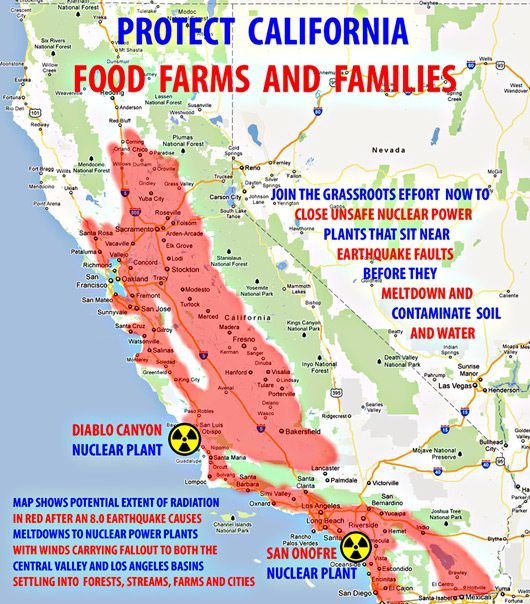
CALIFORNIA NUCLEAR INITIATIVE (CNI). California Against Nuclear Power & Radiation Facebook page. https://www.facebook.com/groups/315704371776383/
Diablo Canyon nuclear power plant sits on the Ring of Fire, and was planned in 1968 when no one knew about the Hosgri fault, a few miles from the coast. Further enquiry established that there had been a 7.1 earthquake forty years earlier, offshore from the plant, which was duly completed in 1973. The power company, Pacific Gas & Electric, said it would beef up defenses. However in their haste, the site managers reversed the new blueprints for earthquake-proofing the two reactors, so the retrofit was not a total success. A moral in the nuclear business, as in any other human enterprise: somewhere along the line people always mess up.
San Diablo was built and retrofitted to survive a 7.3 quake intact. In 1906, San Francisco was destroyed by a 7.7 quake, which ripped the San Andreas Fault for 300 miles, north and south of the city. Another moral: deny the predictable. Diablo Canyon authorities recently learned of yet another fault and are now worried about ‘ground liquefaction’ in the event of a big quake. At last count there are four identified fault lines offshore from San Diablo.
We know 26 years later how horrific the radiation from the Chernobyl meltdown was on the 7 million people affected, half of whom are children. The more recent disaster at Fukushima is considered to be ten times worse and we have yet to see the extent of the radioactive fallout on the oceans, atmosphere and biosphere. We now know that entire populations in the northern hemisphere are victims of Fukushima radioactive fallout, particularly along the Pacific Ocean and the western shoreline states of the U.S. These accidents provide a stark reminder of the real price humanity pays for nuclear technology.
We are all victims and assailants at the same time. Since the force of nuclear power threatens us, we are all victims. Since we continue to use it despite the nuclear disasters of Three Mile Island, Chernobyl, and Fukushima, and have not insisted on clean alternative sources, we are also all assailants.
It is in this spirit that I offer my contribution to WEAD’s Atomic Legacy issue in collaboration with other artists who give their voices to inspire us with the will to live in a nuclear-free world.
I. LIFE IN THE ATOMIC AGE
LIFE IN THE ATOMIC AGE OPENS UP underneath a blanket of government secrecy, unleashing its suicidal warfare onto the world August 6 and 9, 1945, with the bombing of Hiroshima and Nagasaki killing over 200,000 men women and children instantly and another 130,000 who would die of radiation poisoning in the impending five years. As LIFE would have it, their August 20, 1945 issue to five million-plus readers, was devoted to the atomic bomb with full-page photographs of Hiroshima and Nagasaki, with Henry Luce’s photo of the towering mushroom-shaped cloud that would quickly become the universal visual symbol of the atomic-age bomb.
The Manhattan Project. America’s scrupulously controlled Manhattan Project, was set up in three geographically distanced locations: a research site at Oak Ridge, Tennessee, hidden behind a concrete fortress for the production of uranium-235, the Hanford Nuclear Reservation along the Columbia River near Richland, Washington, referred to as the first Atomic City, where weapons grade plutonium was produced, home of the B Reactor the first full scale plutonium production reactor in the world; and Los Alamos, New Mexico a nuclear weapons assembly site where the Hanford plutonium was shipped, first in cars by armed couriers, later by trucks and planes and eventually in specially equipped railroad cars. Nearby Alamogordo readied for the world’s first atomic explosion, July 16, 1945, using a bomb made from Hanford plutonium.
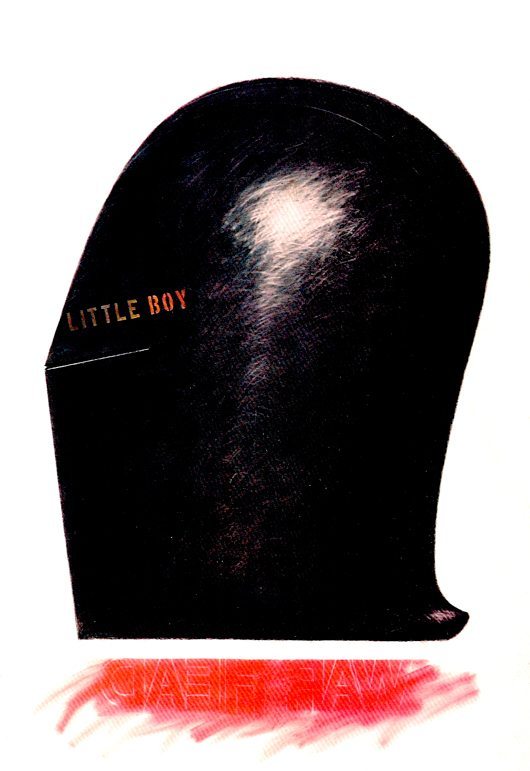
WAR HEAD AND/OR TRANS-HISTORICAL HELMET, Francesc Torres, Disarming Images: Art for Nuclear Disarmament Traveling Exhibit 84-86 Catalog, 1983.
The Manhattan Project initially created and produced two nuclear bombs for its mission. The first, a single four-ton nuclear device containing twelve pounds of Oak Ridge uranium-235, was carried by the Enola Gay. The bomb, nicknamed Little Boy, reached its intended target at 8:15 a.m. with the confirmed success code, ‘It’s a Boy!’ It was an unprecedented death sentence for the men, women and children of Hiroshima. The second four and a half ton bomb containing a few pounds of Hanford plutonium nicknamed Fat Man, was carried to Japan in the B-29 Bock’s Car and dropped in the morning a few days later, on Nagasaki. The dropping of these two bombs ushered in a radically different kind of warfare and irrevocably altered what was considered acceptable moral and ethical behavior during armed conflict.
II. GROWING UP IN THE BOMB’S EARLY LIGHT
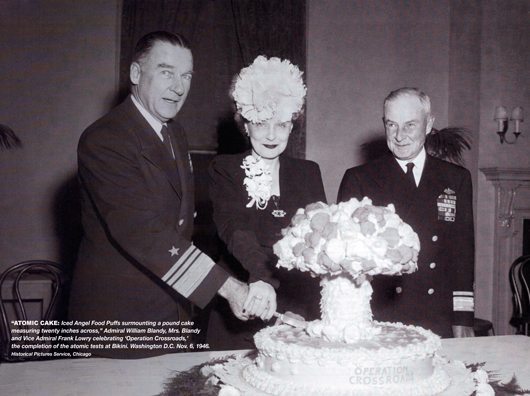
Admiral William Blandy, Mrs. Blandy & Vice Admiral Frank Jacob Lowry celebrate OPERATION CROSSROADS. Washington D.C., 1946.
THE 50s AND 60s MASS CULTURE’S RESPONSE to the atomic age permeated everyday life including General Mills cereal box prizes with atomic bomb rings; movie scripts focused on the secret ingredient of the atomic bomb starring MGM’s well endowed starlet ‘The Anatomic Bomb,’ wearing the latest French fashion designed ‘Bikini’ bathing suit; and at the end of the day one could enjoy a Washington Press Club ‘Atomic Cocktail’ to dull the pain.
There was plenty of really bad humor like the Valentines Day favors, ‘Will you be my little geranium, until we’re both blown up by uranium?’ And the absurd official Washington D.C. photograph depicting a party celebration of the completion of the atomic tests at Bikini ‘Operation Crossroads,’ with a smiling Admiral Blandy and a well clad Mrs. Blandy wearing a hat standing high atop her head mimicking the ‘Atomic Cake: Iced Angel Food Puffs surmounting a pound cake measuring twenty inches across,’ in the shape of a mushroom bomb cloud, Nov. 6, 1946.
The cold war nuclear crisis pervaded American culture with books like On the Beach (1957) Fail-Safe (1962), and Kurt Vonnegut’s satire, Cat’s Cradle (1963), as well as film versions of the same including the popular 1964 black comedy Dr. Strangelove – all imagined scenarios of nuclear war and human extinction.
Duck & Cover civil defense was the order of the day with radio alerts and wailing warning sirens. School children were given identification bracelets or dog tags so their bodies could be identified after a nuclear attack – although I don’t ever remember being told why we were suppose to wear them. At school we were subjected to weekly air-raid drills and told to hide under our desks to protect ourselves from the bomb. In 1961 President Kennedy went on television warning the public of the danger of nuclear war and called for a massive fallout-shelter program. These absurd and naïve evacuation plans along with countless images of bomb shelter ads would only serve to add to our fears and anxieties.
Impressionable and curious I had an inexplicable desire to get up in the middle of the night and go downstairs to the front room and pull every book and magazine off the bookshelf. I would go through them one by one, page by page. For the first time I would see images of burned bodies and blackened shadows of the remains of bodies on sidewalks and walls of the streets and bridges in Japan. Those images have never left my consciousness. This was the world I was born into. I would know no other.
III. THERE IS NO ‘PEACEFUL ATOM.’
THE 50s AND 60s PROMOTED THE ATOMS FOR PEACE program introduced by President Eisenhower as a moral and economic reason to justify the continued production of nuclear weapons, thus opening the way to building the first nuclear reactors for electricity. Of the 104 reactors now operating in the U.S., all had broken ground by 1974 or earlier. It wasn’t until 1976 that the U.S. hypocrisy in the Atoms for Peace program was finally exposed in a Senate study which concluded that Atoms for Peace was an essential part of the U.S. Cold War strategy.
Civilian nuclear energy had a military birth, born for political and economic reasons rather than an energy source. Civilian nuclear plants used uranium fission to yield both uranium and plutonium for bombs and thus became a shield behind which military machinery and military costs could easily hide and expand. Without nuclear energy, proliferation of weapons within one country and across countries would have been less likely. Nuclear energy is the driving force behind proliferation as it spreads nuclear knowledge, hardware and expectations of belonging to the nuclear firepower club.
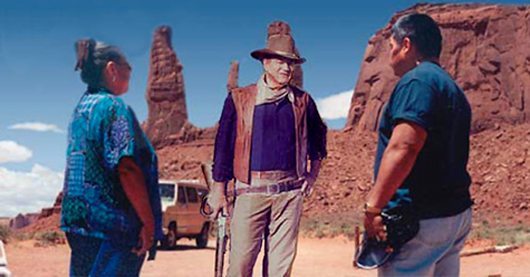
THE RETURN OF NAVAJO BOY, Groundswell Educational Films documentary, 2012. http://navajoboy.com/
URANIUM MINING. Simultaneously the Atomic Energy Commission (AEC) contracted private mining companies to create thousands of uranium mines to help fuel their nuclear weapons program, with 92% of all western mines located on the Colorado Plateau. The Navajo Nation encompassed portions of Arizona, New Mexico and Utah and became a key area for over 1000 uranium mines. Between 1944 and 1989, 3.9 million tons of uranium ore were mined from the mountains and plains. The AEC and the private mining companies failed to inform the Navajo workers of the known risks of exposure to uranium.
In 1950, the U.S. Public Health service made a massive study of uranium miners, leading to the first publication of a statistical correlation between cancer and uranium mining, released in 1962. Studies provided data to show that the Navajo mine workers and numerous families on the reservation had suffered high rates of disease from environmental contamination, but for decades industry and the government failed to regulate or improve conditions, or inform workers of the dangers. Hundreds of abandoned uranium mines across the 27,000 square miles of Navajo territory still contaminating the Navajo Nation are the legacy of shoddy mining practices and federal neglect.
IV. RADIOACTIVE FALLOUT
THE U.S. BEGAN ATMOSPHERIC TESTING OF multi-megaton thermonuclear bombs in the Pacific with the Bikini test in 1946, but it wasn’t until the 1954 test series that aroused public alarm and attention with the spreading of radioactive ash over seven thousand square miles damaging ecosystems and forcing the emergency evacuation of nearby islanders, bringing illness and death to Japanese fishermen eighty miles away. In 1955, radioactive rain fell on Chicago. In 1959, deadly strontium-90 showed up in milk. The Saturday Evening Post ran a feature ‘Fallout: the Silent Killer.’
A national movement against nuclear testing began as Adlai Stevenson raised the issue in his 1956 presidential campaign, and SANE – the National Committee for a Sane Nuclear Policy – was formed along with Bernard Lown’s Physicians for Social Responsibility. A new group of scientists and physicians warned of the health hazards of fallout, including leukemia, bone cancer, and long-term genetic damage which sparked a national movement against nuclear testing. In 1963 the U.S., Soviet Union and Great Britain signed a treaty banning atmospheric testing.
In the late 60s and 70s much attention was given to the Vietnam War, and the American public scarcely noticed that the U.S. tested more nuclear weapons in the five years after the ‘test ban’ treaty than in the five years before. Both the U.S. and Soviet Union found the loopholes in the 63 test-ban treaty and developed sophisticated methods of underground testing. Although the arms-control agreements of SALT I (1972) were a step in the right direction, the country’s nuclear weapons program went full speed ahead stockpiling its arsenal between 1963-1980 with more and more weaponry, never falling short of a minimum of 24,000 nuclear warheads during those years.

SAFE AS MOTHER’S MILK: The Hanford Project. http://www.hanfordproject.com/
SAFE AS MOTHER’S MILK. The Hanford project expanded to include nine nuclear reactors and five large plutonium processing complexes with the help of its largest contractor General Electric. Over its 40 years of operation Hanford produced 57 tons of plutonium for most of the 60,000 weapons in the U.S. nuclear arsenal resulting in 177 underground nuclear toxic waste tanks. Nuclear technology developed rapidly during this period, but many of the early safety procedures and waste disposal practices were inadequate, and government documents have since confirmed that Hanford’s operations released significant amounts of radioactive materials into the air and the Columbia River, which continues to threaten the health of residents and ecosystems.
The Hanford nuclear legacy left an irreversible mark on what was once a small farming community and home of native peoples as far back as ten thousand years, exposing communities to radioactive contaminated air, water, and land throughout Washington, Idaho, Montana, Oregon and British Columbia. The Native American people who lived off the land were disproportionately affected, as they fished salmon in the rivers and tributaries of the Columbia River and hunted on the lands for survival.
V. ANTI-NUCLEAR MOVEMENT REBOUNDS
A REVIVAL OF NUCLEAR AWARENESS IN AMERICA and Western Europe in the late 70s was sparked by the planned NATO deployment of Pershing and Cruise missiles with nuclear warheads. Grassroots opposition to nuclear power was spreading throughout America in 1979 with the release of Jane Fonda’s China Syndrome and the nuclear accident of Three Mile Island. Activists were not only focusing on nuclear power but were looking at the interconnectedness of the entire nuclear industry on society with its economic promise, its public health and safety problems and its threat to the environment. As Ronald Reagan steps to the plate with his rhetoric for a vast military buildup including pushing nuclear arms into space with Star Wars, a revived cultural awareness begins to take place renewing the anti-nuclear protest movement. On June 12, 1982, one million people demonstrated in New York City’s Central Park against nuclear weapons and for an end to the cold war arms race. It was considered the largest anti-nuclear protest and political demonstration in American history.
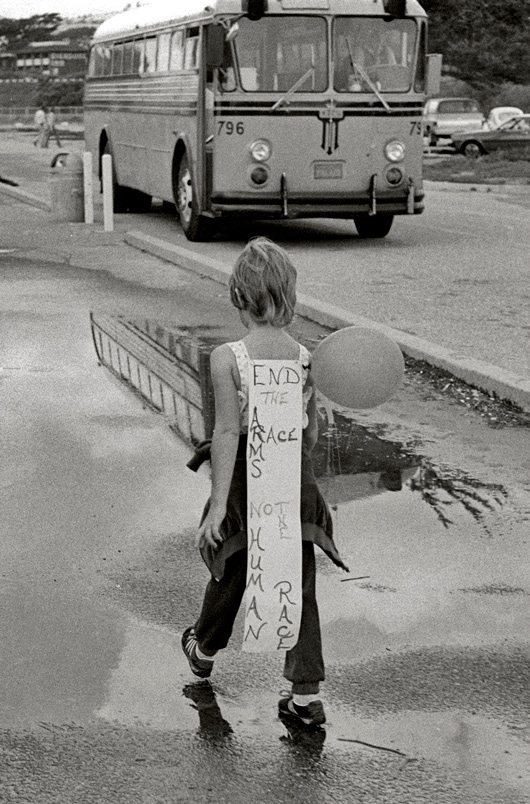
END THE ARMS RACE, NOT THE HUMAN RACE, Laura Lynch, Photo mural (Peace March, Ventura, California), 1983.
THE ART OF PROTEST. In 1983 while attending California Institute of the Arts MFA program, I created my first anti-nuclear installation, ‘Living With a False Sense of Security.’ I was inspired by a quote I read from H.V. Kaltenborn, a NBC news commentator after the bombings of Japan: ‘We are like children playing with a concentrated instrument of death whose destructive potential our little minds cannot grasp.’ I sent a letter to the administrators of Southern California Edison’s San Onofre Nuclear Generating Station, also known as SONGS, requesting information, and in return they sent me a large packet of promotional material. Their information was a distorted reality of a clean safe energy source which included cards describing ‘HOW WE CAN SAFELY DISPOSE OF NUCLEAR WASTE’ with borosilicate glass attaching black marbles to the cards to illustrate their point.
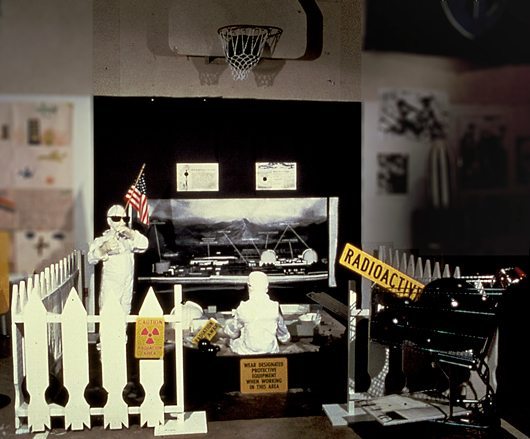
SONGS CHILDREN PLAY, Laura Lynch, International Anti-War Exhibition during 84 Olympics, Venice, California, 1984.
I appropriated the text and images of their promotional material incorporating a sandbox with plaster cast figures of two children building a model nuclear power plant and a toy train running through the gallery transporting their black marble nuclear waste spilling out onto the gallery floor. The installation also included an ‘information’ area with reading material, petitions and postcards for visitors to the gallery to sign and send to their local and state representatives. The sandbox and SONGS installation ‘SONGS Children Play’ was later exhibited in an international anti-war group exhibition in Venice, California during the 1984 Olympics. I included a white picket fence in the shape of bombs alluding to the connection of nuclear power and nuclear weapons and added to the black marble waste to include various sizes in the shape of basketballs and beach balls.
VI. NAMING THE NUKES
THE U.S. ROLE IN THE 80s IN THE PROLIFERATION of nuclear weapons brought about a resurgence of anti-nuclear groups including Nuclear Free America, an international clearinghouse and resource center for Nuclear Free Zones. They provided lists of the top nuclear weapons contractors and the consumer products they manufactured. Their mantra was ‘If you oppose nuclear weapons why support the corporations that build them?’ I began to collect the lists of the top 50 Nuclear Weapons Contractors and their products and supported their pledge: ‘As a supporter of the Campaign for a Nuclear Free America, I pledge not to invest in, do business with, or purchase products made by the Top 50 nuclear weapons contractors.’
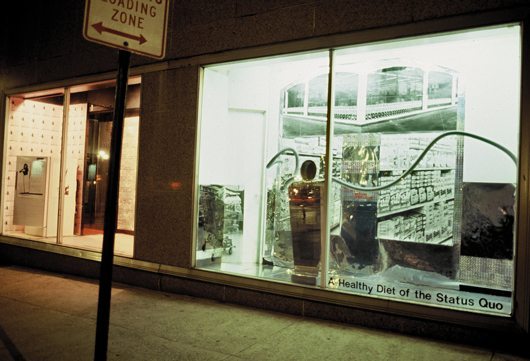
CONSUMER CONNECTION: A HEALTHY DIET OF THE STATUS QUO, Laura Lynch, Three public windows downtown New Brunswick, NJ, 1984.
While attending the Whitney Museum’s Independent Studio Program, I was invited by Martha Rosler and Mason Gross School of the Arts at Rutgers University, to create an installation in three public windows in downtown New Brunswick, New Jersey, which I entitled, ‘Consumer Connection, A Healthy Diet of the Status Quo.’ I used the opportunity and public arena to highlight the names of the top nuclear weapons contractors printed on pink rose petal wallpaper and the consumer products they manufactured – a handout list was printed on ‘Home-Sweet-Home’ wallpaper and made available to the public throughout the two-month exhibit. I had incorporated large photomurals and transparencies of shopping carts and grocery shelves on windows and mirrors looking in and looking back out at ourselves.
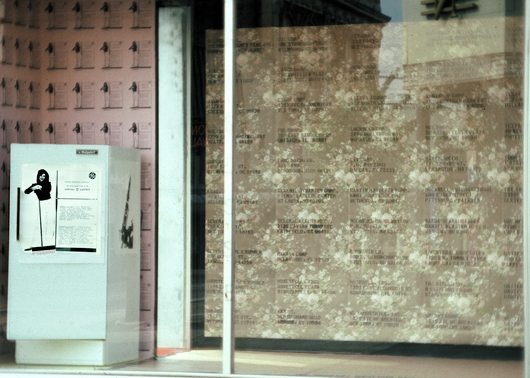
CONSUMER CONNECTION: A HEALTHY DIET OF THE STATUS QUO, Laura Lynch, Three public windows downtown New Brunswick, NJ, 1984.
CHERNOBYL DISASTER. On April 26, 1986 the disaster at Chernobyl atomic power station released 80% of the reactor core’s content – radiation equivalent to 1,000 Hiroshima bombs, not the officially claimed three percent. At the time it was the most massive technological accident to have ever happened on the planet. It was an ecological catastrophe of international proportions bringing grievous harm to the peoples of Belarus, Ukraine and Russian Federation. According to the U.N., 7 million people are now affected, half of whom are children. In Belarus alone, almost five hundred thousand children are victims of Chernobyl. The Thyroid Tumor Center in Minsk indicates thyroid cancer has increased by 2,400%.
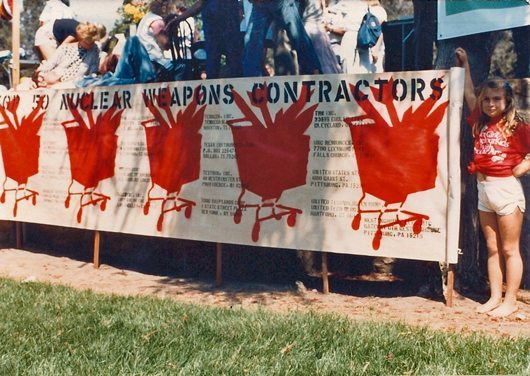
Peace Festival Installation, Laura Lynch, (daughter wearing WAND t-shirt: ‘You Can’t Hug Your Children With Nuclear Arms.’), Santa Barbara, 1986.
In 1986, hundreds of people walked from Los Angeles to Washington DC in the Great Peace March for Global Nuclear Disarmament. I sent three large posters of my work to be displayed at the march with a representative from Santa Barbara. For fear of another Chernobyl, I was moved to organize a Santa Barbara chapter of Women’s Action for Nuclear Disarmament (WAND) a national organization founded in 1982 by Helen Caldicott. I also cofounded Citizens Action for Nuclear Disarmament (CAND) a local group that helped to get an initiative (‘Measure N’) written and put on the local ballot asking Congress to redirect monies from Star Wars and the military to meet more human needs. It was the first ballot measure of its kind in the country and it passed by 54% of the vote, and received national news.
VII. THE MAN BEHIND THE MAN BEHIND THE GUN
IN 1988, I RECEIVED A NATIONAL Endowment for the Arts grant along with five other installation artists from California for a group show, ‘Tableaux Vivante/Morte,’ at San Diego’s Installation Gallery. I used part of the NEA funds to hire an assistant to gather information and create computer files with facts and figures essential for a site specific installation centered around the nuclear weapons industry entitled, ‘The Man Behind the Man Behind the Gun: A San Diego Nuclear Weapons Database Project.’
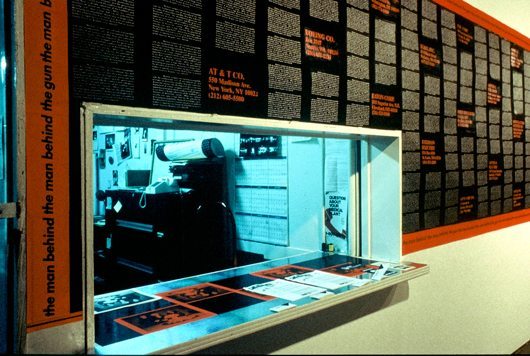
THE MAN BEHIND THE MAN BEHIND THE GUN: A SAN DIEGO NUCLEAR WEAPONS DATA BASE PROJECT, Laura Lynch, 40ft collage (detail), San Diego Installation Gallery, 1988.
I created a 40-foot running checkerboard collage listing names and addresses of the top 100 nuclear weapons contractors and repeated the statement by the Lawyer’s Committee on Nuclear Policy throughout using computer generated mixed media quickly applied and produced: crack ‘n peal, adhesive drafting film, laser paper, and paper in continuous form.
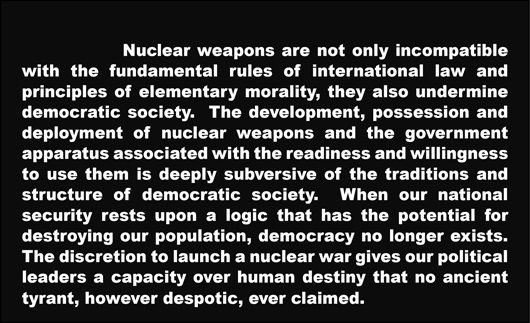
THE MAN BEHIND THE MAN BEHIND THE GUN: A SAN DIEGO NUCLEAR WEAPONS DATA BASE PROJECT, Laura Lynch, 40ft collage (detail), San Diego Installation Gallery, 1988.
The weapons contractors’ consumer products were laser printed on mylar rainbow paper with handout lists available in the gallery. Another wall in the gallery listed San Diego’s nuclear weapons contractors, where they were located and what contracts they were involved in – all laser printed on clear adhesive drafting film and applied directly to the gallery’s 12×16 ft. wall. ‘The San Diego Nuclear Free Zone Ordinance’ written by the Lawyers’ Committee on Nuclear Policy was posted on a column in the center of the gallery. This model legislation has been successfully used in many cities and is designed to ban the manufacture of nuclear weapons within the jurisdiction of a given locality.
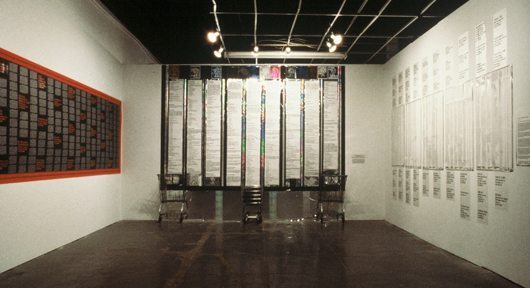
THE MAN BEHIND THE MAN BEHIND THE GUN: A SAN DIEGO NUCLEAR WEAPONS DATA BASE PROJECT, Laura Lynch, San Diego Installation Gallery, 1988.
‘The man behind the man behind the gun’ was a slogan used by Honeywell during World War II and one of the top nuclear weapons contractors. Naming the Nukes doesn’t stop at the corporate door. In identifying the multinational corporations involved in the production and sale of nuclear weaponry, including the companies working on nuclear weapons contracts in San Diego, the tableaux also revealed the connection between the massive interventions of nuclear armament production into the economy as a whole. In the ‘consumer connection tableaux,’ we find ourselves participating in the act of complicity as we purchase the consumer products that are manufactured by the same corporations who are producing the means for destruction. The consumer joins the ‘man behind the man behind the gun’ as she/he participates in, perpetuates and gives her/his general consent to the power relations involved in corporate industry.
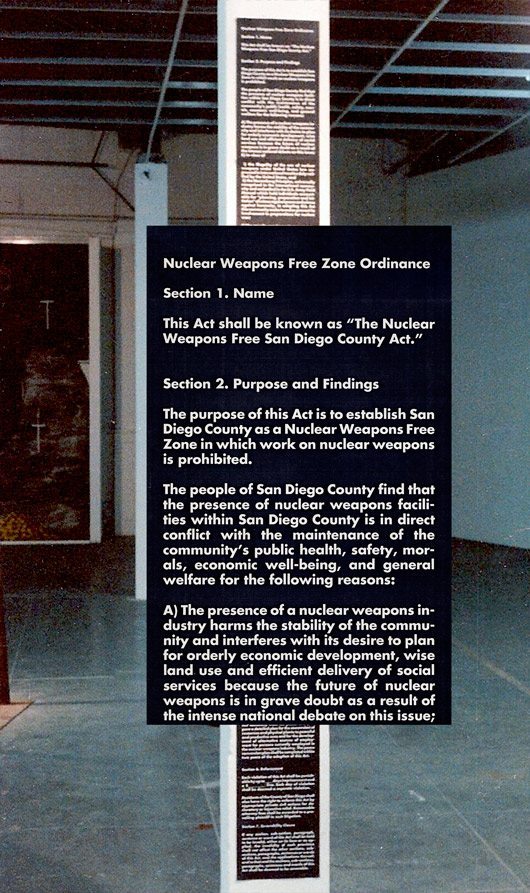
THE MAN BEHIND THE MAN BEHIND THE GUN: A SAN DIEGO NUCLEAR WEAPONS DATA BASE PROJECT, Laura Lynch, San Diego Installation Gallery, 1988.
HAIR TRIGGER AWAY. The medium of computer technology, computer programs, and laser printers used to produce this work is particularly important to the production of meaning within the work as it relates to the dangers involved with the increasing computerization of society in the production and dissemination of information in a nuclear age. In order to process the growing volumes of information from many different sources and to have the current capability to reach a decision within three minutes, nations’ nuclear attack early warning systems are being increasingly computerized. Computers now advise what targets to hit and with which missiles.
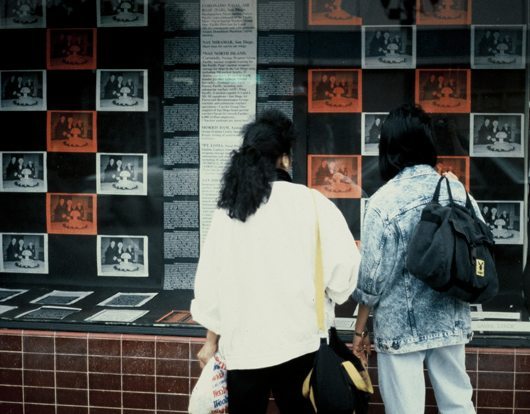
THE MAN BEHIND THE MAN BEHIND THE GUN: A SAN DIEGO NUCLEAR WEAPONS DATA BASE PROJECT, Laura Lynch, San Diego Balboa Theater building window, 1988.
Part of this tableaux was simultaneously exhibited at two other public sites – a window display and poster marquis on the street located about 6 blocks from the gallery in the empty Balboa Theatre building. The display window on the street incorporated the same materials and subject matter employed in the gallery, but shifts its address to the general public whose concern it is to know about the nuclear weapons infrastructure located in San Diego — most of which exists within a mile of downtown. The information in the window focused on the Navy and nuclear submarines located in the San Diego harbor. The ‘San Diego County Nuclear Weapons Free Zone Ordinance,’ was displayed a few yards away below the theater marquis in their poster window.

THE MAN BEHIND THE MAN BEHIND THE GUN: A SAN DIEGO NUCLEAR WEAPONS DATA BASE PROJECT, Laura Lynch, San Diego Balboa Theater building window, 1988.
During the two-month exhibition period, I arranged for local groups Economic Conversion, Amnesty International and Nuclear Free America, to hold their meetings and events in the gallery in an effort to encourage local people to become involved in changing the current status of nuclear weapons production and nuclear weapons transportation in San Diego County.
VIII. IRISH BEACON AT SEA
IN THE EARLY 90s I MOVED BACK TO the beach and began collecting and gathering marine salvage on my daily walks. Soon I had an unruly stash that overtook my workspace. I set about organizing the volumes of collected debris by size, color, shape, wood, fiberglass, metal, plastics, tar, etc. This was the beginnings of ‘PACIFIC SERIES’ an assemblage of works I would create addressing issues of environmental concern from nuclear waste and nuclear weapons production to toxic spills and the threat to our world’s oceans and marine habitat.
I was inspired to continue this work when I went to Ireland in 1996 for a family reunion and discovered that my family name ‘Lynch,’ means ‘Descendant of Loingseach,’ meaning ‘mariner,’ from ‘Long’ for ‘ship or mariner.’ I also discovered the ‘red skerrie savers’ in a small coastal town, Skerries, Ireland, along the Irish Sea. These bright red framed housings dot the shoreline like beacons each holding a lifesaver to throw out into the sea to swimmers in trouble. It was there I met an Irish family who live on the beach, but they said they don’t go near the water or let their children go swimming in the ocean because it’s polluted – in fact it’s the most polluted ocean in the world they said because of the British nuclear reprocessing plants which are discharging thousands of gallons of radioactive waste daily from the British shore into the Irish Sea.
I have appropriated the image of the red skerrie saver in a number of assemblages in this series, as a symbol of hope for future generations, and as a warning sign of how the entire human species might very well need to be saved one day from drowning in a sea of ignorance and greed. My goal is that one day these beacons will be adapted for signage and installed along the Pacific Ocean coastline to provide water quality and safety information while reminding us of how precious our environment is and how we must all share in the responsibility of its protection.
IV. CONCLUSION
‘IT’S A STRANGE PHENOMENON OF JOURNATLISTIC life today that the greatest potential ‘story’ of our time – the self-extermination of mankind in a nuclear holocaust – is one that by its very nature can never be written. ‘NUCLEAR WAR ERUPTS – WORLD ENDS’ is a headline that we’ll never see… The time to file our reports, to write our headlines, to raise our monuments, to write our poems and songs- and most important to act to prevent this inconceivable fate – is now, while we are still around.”
—The New Yorker, November 1983.
While the consciousness of the 80s was shaped by the threat of nuclear war, the consciousness of the 21st century has ushered in more of an urgency and awakening of the global community. As the fallout of the Fukushima disaster makes its way across the globe, there is no escaping it. Its relentless radioactive plumes drift endlessly knowing no borders. Nuclear power has left its deadly legacy as a stark reminder of the real price humanity pays. We must not take this latest nuclear disaster in stride as though it will not happen again. It is true that we cannot live our lives as if the end of the world could occur. And it is also true that it is a reality of our lives that we have to live them in the context of that possible occurrence. These truths are incompatible, but they have come closer together than ever before and will continue to do so if we do not act to reverse our nuclear policies.
Artists confront the present danger, emotionally as well as intellectually, and give voice to it. Historically artists have served as the conscience of humanity. We also serve as the conscience of the Earth itself as an act of stewardship and a new reintegration of consciousness. We must continue to be vigilant to prevent another Chernobyl or Fukushima and the horrifying consequences of these catastrophes; we must forever halt uranium mining, shut down nuclear power plants and abolish nuclear weapons to save humanity and guarantee its survival.
END NOTES
1. Hanford Environmental Dose Reconstruction Project. ‘How to Get Your Hanford Radiation Dose Estimate.’ By Trisha Pritikin, Author and Hanford Nuclear downwinder. 1999.
2. Safe As Mother’s Milk: The Hanford Project. http://www.hanfordproject.com/
3. Wikimedia Commons.
4. LIFE Magazine Archive; http://www.books.google.com
5. Dr. Helen Caldicott, http://www.nuclearfreeplanet.org/
Radio: http://www.ifyoulovethisplanet.org
6. California Nuclear Initiative (CNI). California Against Nuclear Power & Radiation
Facebook Page, https://www.facebook.com/groups/315704371776383/
7. Francesc Torres. ‘War Head and/or Trans-Historical Helmet’ Disarming Images: Art for Nuclear Disarmament. Nina Felshin, Curator. Traveling Exhibition 1984-1986. An exhibition catalog by Bread and Roses.
8. THE HIROSHIMA PANELS by Maruki and Toshi Maruki, 1950-1982.
9. In The Bomb’s Early Light. American Thought and Culture at the Dawn of the Atomic Age. By Paul Boyer. Pantheon Books/New York, 1985.
10. Stocking the Arsenal: A Guide to the Nation’s Top Military Contractors, Investor Responsibility Research Ctr. Washington D.C., 1986.
11. AT WORK IN THE FIELDS OF THE BOMB. Photographs and Text by Robert Del Tredici. Harper & Row Publishers, 1987.
12. NUCLEAR CULTURE. Living & Working in the Worlds’ Largest Atomic Complex. By Paul Loeb. New Society Publishers, 1986.
13. Lawyers’ Committee on Nuclear Policy (LCNP). Nuclear Weapons Free Ordinance. New York, New York. Founded in 1981, LCNP is a national nonprofit educational association that uses national and international law to promote peace and disarmament. LCNP is a vital link between policy makers, legal scholars and activists.
14. OVER OUR DEAD BODIES: Women Against The Bomb, edited by Dorothy Thompson. Virago Press, 1983.
15. Women On War. Essential Voices for the Nuclear Age From a Brilliant International Assembly. Edited by Daniela Gloseffi. Touchstone. New York, New York, 1988.
16. CRITICAL MASS Voices For a Nuclear-Free Future, Edited by Greg Ruggiero & Stuart Sahulka. Open Media and the Campaign for Peace and Democracy, 1996.
17. TESTIMONIES: Chernobyl Papers #1. CHERNOBYL 10 Yrs After. Greenpeace Int’l. 1996.
18. Chernobyl Legacy. Photographs and text by Paul Fusco. MAGNUM Photos. 2011. http://inmotion.magnumphotos.com/essay/chernobyl
19. ‘The Talk of the Town: Notes and Comment,’ The New Yorker, 21 Nov. 1983, p. 41.
20. ‘DANGER: Men Working’ details & ‘Red Skerrie Saver #2’ detail. PACIFIC SERIES: Environmental Assemblages by Laura Lynch. Blurb Inc. Seattle, Wash. 2008. http://www.blurb.com/books/439458

